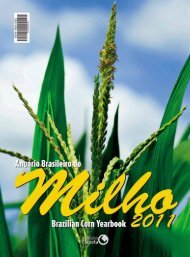tradicionalmenteinovador - Brazil Buyers & Sellers
tradicionalmenteinovador - Brazil Buyers & Sellers
tradicionalmenteinovador - Brazil Buyers & Sellers
Create successful ePaper yourself
Turn your PDF publications into a flip-book with our unique Google optimized e-Paper software.
Inor Ag. Assmann<br />
The king of the area<br />
>> Tomato is economically the<br />
most important horticultural<br />
crop produced in <strong>Brazil</strong> and its<br />
destination for industrialization<br />
is gaining momentum<br />
With a share of upwards of 24 percent of total vegetable<br />
supplies in <strong>Brazil</strong>, the tomato crop contradicted the general<br />
picture of the sector and soared 11.43% in 2009. This happened<br />
because the volume produced (both table and industrial tomatoes)<br />
exceeded 4.3 million tons. The sales value kept pace<br />
with the trend and pushed the commodity to the top position,<br />
previously occupied by the potato crop, reaching almost R$ 6.5<br />
billion. What contributed to this end was the expressive rise in<br />
the price per ton, from R$ 1,090 to R$ 1,500, according to data<br />
released by Embrapa Vegetables, in Brasília (DF).<br />
For 2010, information initially disclosed by the team of the<br />
Hortiftruti department at the Center for Advanced Studies on<br />
Applied Economics, run by the Luiz de Queiroz College of Agriculture,<br />
linked with the University of São Paulo (Cepea/Esalq/<br />
USP), on the leading cultivation regions, attested to the continuity<br />
of the regular 4.6-percent increase in area. The 2010/11<br />
summer season, on the other hand, due to unstable prices as<br />
of July 2010, pointed to similar reductions (4.2%), whilst for the<br />
winter season it reached higher levels (6.3%).<br />
The <strong>Brazil</strong>ian Institute of Geography and Statistics (IBGE),<br />
in its Systematic Agricultural Production Survey, conducted in<br />
May 2011, concluded that the 2010 season, in terms of area<br />
and production, had made a comeback to the levels of the<br />
2008 season, and predicted the maintenance of these levels<br />
throughout 2011. The leading producing regions, with more expressive<br />
planted areas, are located in Itapeva and Mogi-Guaçu,<br />
in the State of São Paulo; Araguari, in Minas Gerais; Caçador, in<br />
Santa Catarina; and Caxias do Sul, in Rio Grande do Sul.<br />
The bulk of the <strong>Brazil</strong>ian tomato crop is destined for the<br />
dining table, but the amounts destined for the industry (the socalled<br />
trailing tomatoes) are capturing the attention for their<br />
commercial relevance. The president of the <strong>Brazil</strong>ian Horticultural<br />
Association (BHA), Paulo César Tavares de Melo, also a<br />
professor at the Vegetable Production Department at the Luiz<br />
de Queiroz College of Agriculture (Esalq), a division of the University<br />
of São Paulo (USP), came up with statistical figures of the<br />
year 2010 pointing to a production volume of 1.8 million tons,<br />
up 58% from the year 2000. This increase in volume pushed<br />
<strong>Brazil</strong> to the fifth position among the top global producers,<br />
earning an official membership status in the World Processing<br />
Tomato Council (WPTC), an organ to which Melo officially<br />
serves as <strong>Brazil</strong>’s nominated delegate.<br />
The leading tomato producer in <strong>Brazil</strong> is the State of Goiás,<br />
with 1.466 million tons from a planted area of 16,382 hectares<br />
(yields of 89.5 t/ha). The average productivity in the Country is<br />
up 150% from 1985, a fact that is attributed to the concentra-<br />
68





